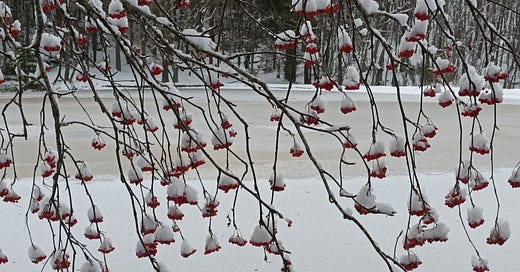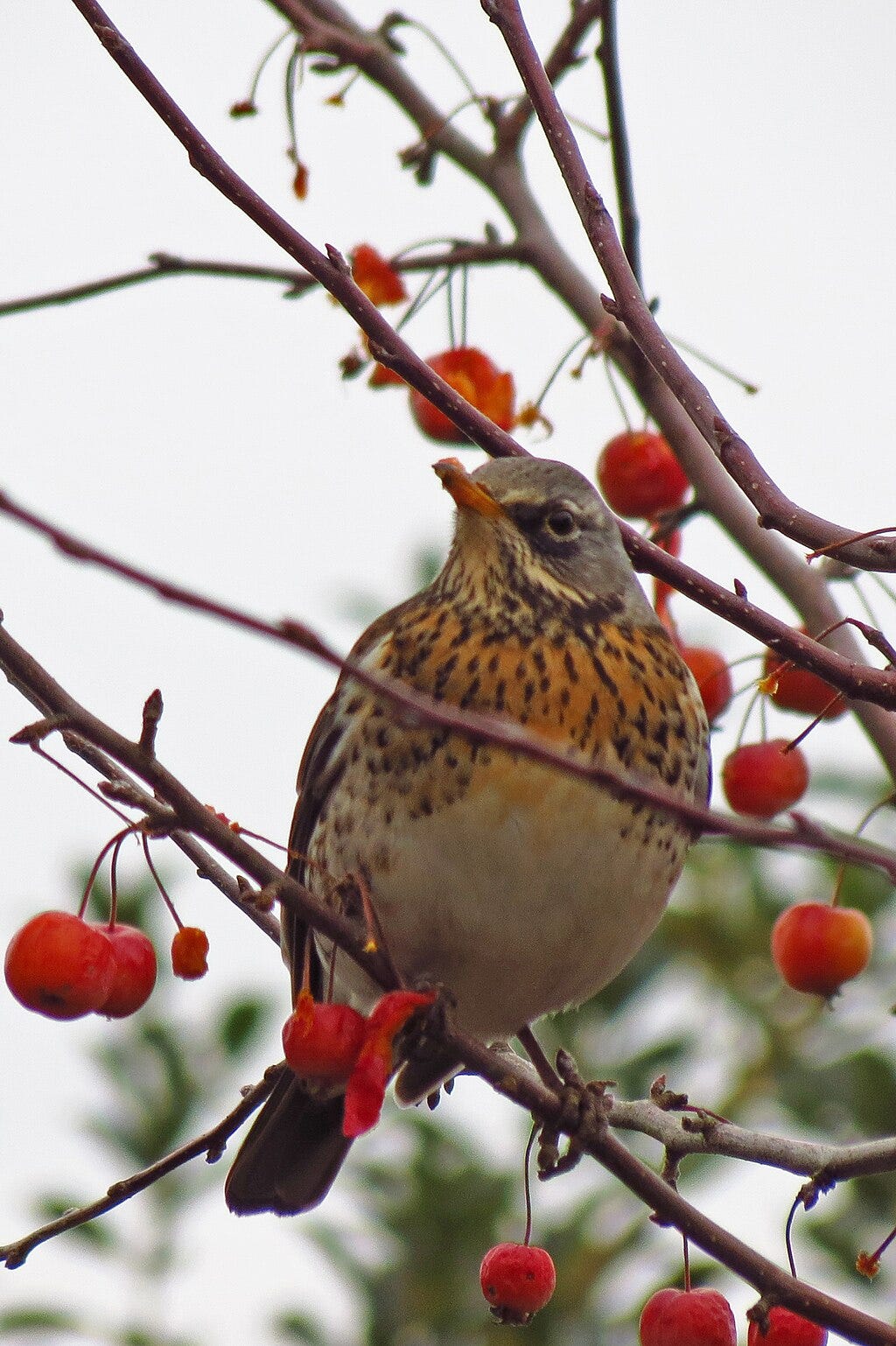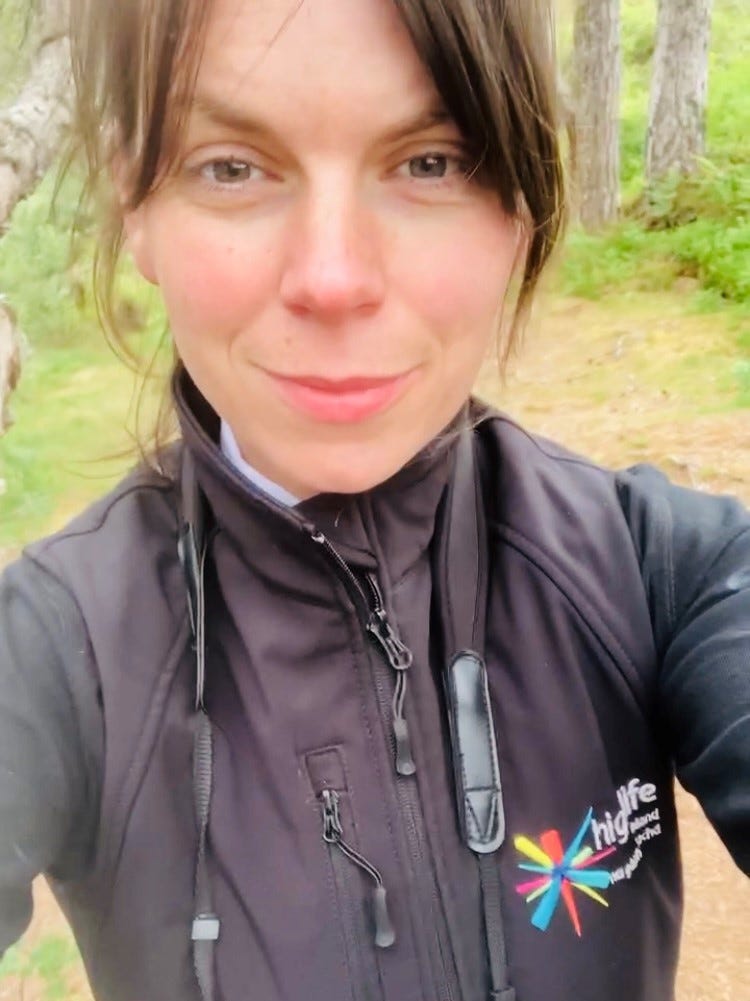One day, in the middle of November this year, I took a lunch break walk up Ullapool Hill. As is quite often the case with exciting wildlife encounters, I had not gone on the walk expecting to see anything.
It quickly became apparent however that my dog Milly and I were not alone. On the lower paths where there are trees in abundance, the sky was alive, and the sound that filled my ears was also impossible to ignore. There was a mechanical chattering from all directions as birds flitted between different trees.
There was not just a dozen, but hundreds of these birds. Getting my ear and eye in, for it was a whole year since I had seen them, I realised they were predominantly fieldfare with some redwing. Both bird species are members of the thrush family and flock together in the winter. We often see resident thrushes related to them; blackbirds and song thrush for example.
The redwings and fieldfare come over from Scandinavia and Russia when the weather gets wintery there, often joined by waxwing. Searching for food, there is one tree that stands out to them, the rowan. The time of year that they are searching for food coincides with these beautiful berries being ripe and bright.
It is a mutual relationship between the bird and tree. The rowan ‘wants’ its seed to be spread far and wide by birds and it is no coincidence that they can see colours in the red spectrum. The birds can see red berries from a distance and home in on the tree. They strip them bear in no time at all.
You may find rowan trees dotted about on crags on a hill, gnarled and twisted by wild weather and wonder how they came to grow there. The answer is the birds. The berries are excreted wherever the bird chooses to release them and if conditions are right a new rowan tree can grow. Perhaps why the rowan is also known as the mountain ash.
I noticed this year in the northwest that the rowans were full of berries, a lot more so than usual. It was so astonishing to see so much red in amongst the autumnal colours during the settled autumn we had. I took many photos of them to remember their vibrancy.
The saying goes that if rowan berries are out in force, then a hard winter is on the way. We certainly had a snowy time in mid November so maybe there is some truth in it. Time will tell.
But from an ecological perspective, I remember commenting on a guided walk in the spring to people how incredible the rowan blossom was this year. The blossom, like the berries, really stood out and their earlier appearance coincided with warm weather in the spring, good for the pollinators and resulting several months later in lots of berries.
Back on the hill path, the fieldfare and redwing I saw on the hill stopped me in my tracks long enough for another walker to pass me on the path. I couldn’t help but tell him excitedly about what he was witnessing all around. He hadn’t heard of these visitors from over the North sea before but was interested when I explained what they were and where they had come from.
He moved on and I kept looking, trying to count them, but finding it impossible with their continuous movement. It was a bright sunny day with a snowy scene and as a big flock of them took off, and passed over my head, they flashed in the sun, the fieldfares belly reflecting the light with every wing beat. I was mesmerised by the glittering sky and once again humbled and in awe of the natural world.

This is not just a story of the birds but of weather systems, pollination and parallel evolution between the rowan its red berries and birds wanting to eat them (that has evolved over thousands of years) and of wildlife that knows no borders.
All parts of the cycle sit in delicate balance, all need each other, the trees, the birds, the insects, not to mention the fungi in the soil and simply having the space to grow and survive. And that is ecology, something we need to look after as a whole and something we are part of too.
And now the rowan tree berries have been gorged on and the red colour has nearly disappeared from the landscape but I am okay with that knowing that when I see a rowan tree braced for the winter with bare branches, it and other rowans have filled the stomachs of hundreds and thousands of these migratory birds so that they might survive the winter and breed again next year.
And so the cycle continues.
Jenny Grant is the dedicated High Life Highland Countryside Ranger for Wester Ross, operating out of Ullapool Library. With a profound commitment to community engagement, Jenny concentrates her efforts on building connnection between the community and their natural environment. Her work is driven by an unwavering passion for the natural world, encompassing a broad spectrum of interests from local flora and fauna to broader ecological systems. Jenny views learning about the Highland's unique ecology as a lifelong journey, one that she enthusiastically shares with others. Her role not only involves conservation efforts but also educating and inspiring the public about the importance of preserving the natural beauty and biodiversity of the Highlands.
What changes may be in store for birds as we think about the climate and the future?
Join Andy Summers on 5th December to find out as he explores how climate change is affecting our bird populations in the Highlands of Scotland: What species are most vulnerable and how are they are adapting in a complicated picture of interacting processes. Andy will examine prediction of what will happen to our birds in the near future.
In the face of global biodiversity loss and climate change, the need to protect and restore our bird species and their ecosystems has never been so critical.
Reserve your space on the talk here:









Thanks for this vivid illustration of the interconnectedness of life!
I love the stories you rangers weave. Of interconnectedness, place, passing time, hope.